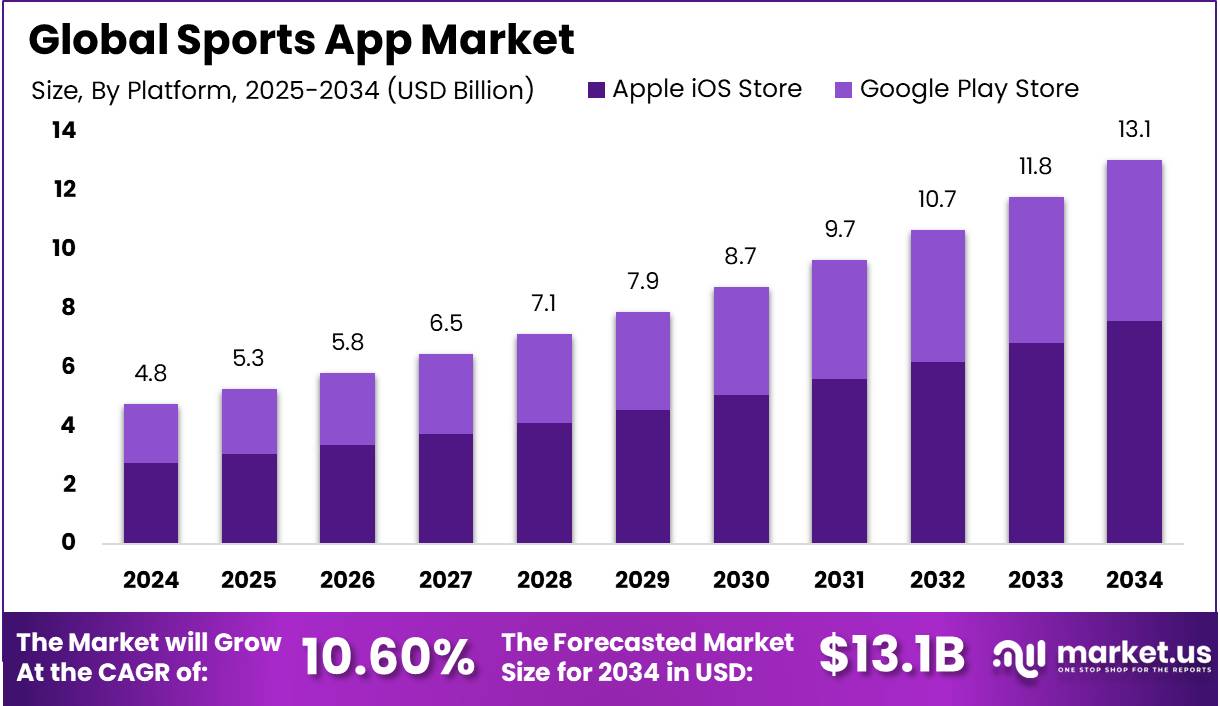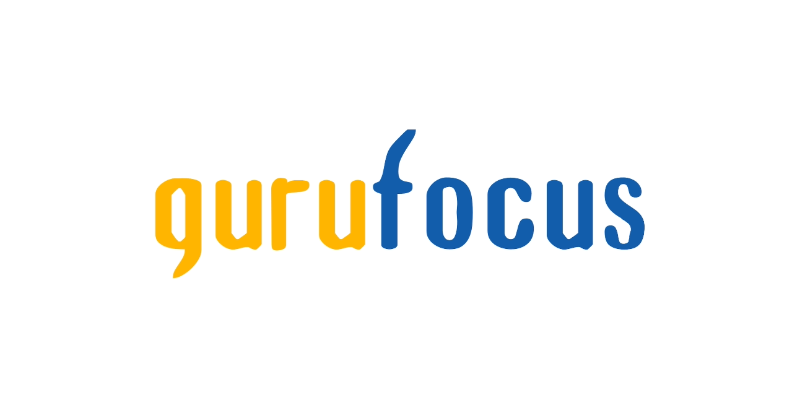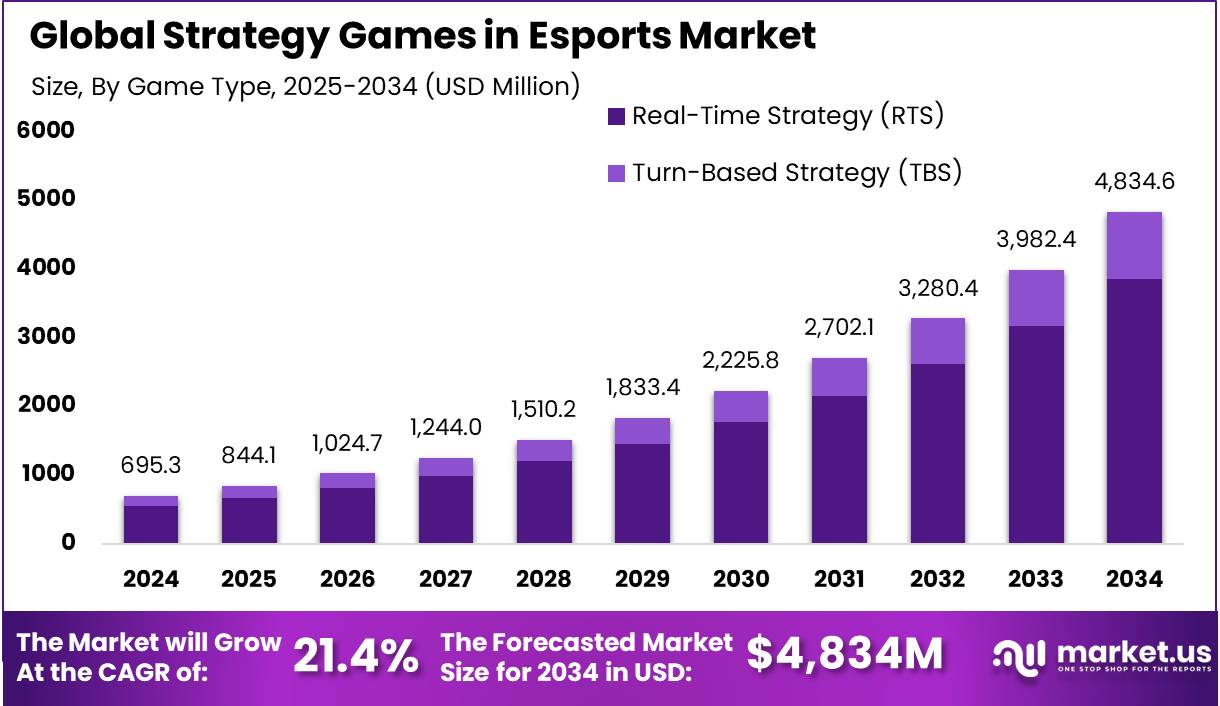Report Overview
The global sports app market is undergoing a robust transformation, with its size projected to reach approximately USD 13.1 billion by 2034, rising from USD 4.77 billion in 2024. This promising growth reflects a steady compound annual growth rate (CAGR) of 10.6% between 2025 and 2034.
In 2024, North America remained the leading regional contributor, accounting for more than 36% of the global market share, with revenue generation of around USD 1.71 billion. Within this region, the United States alone was valued at approximately USD 1.62 billion, and the market is forecasted to advance at a CAGR of 8.4% over the coming decade.
Key factors propelling this market include the rising focus on health and wellness, the integration of artificial intelligence (AI) and machine learning for personalized workout plans, and the growing popularity of live sports streaming and real-time score tracking. The demand for sports apps is further bolstered by the increasing use of wearable fitness technology, which allows for real-time performance monitoring and enhanced user engagement.
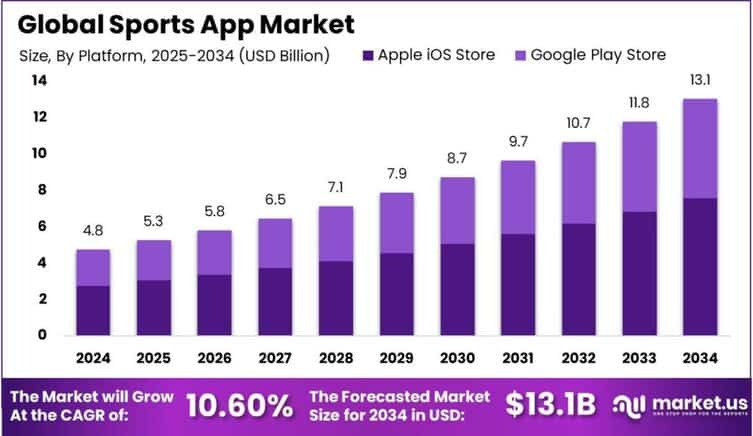

Sports apps provide several benefits, including personalized fitness plans, real-time game updates, and community interaction. These features help users manage health goals, stay updated on their favorite teams, and connect with others. By offering expert advice and structured programs, these apps democratize fitness and sports knowledge, making it accessible to a wider audience.
The intersection of sports and technology offers opportunities for innovation, including virtual reality, gamification, and social media integration to boost engagement. Expanding into underserved markets and developing niche apps can drive growth, while collaborations with sports organizations and influencers can enhance reach and credibility.
Developers and companies are undertaking various initiatives to enhance the functionality and appeal of sports apps. These efforts include advanced performance analytics, multilingual support, and strong data privacy. There’s also a focus on creating inclusive platforms for users of all abilities and fitness levels, fostering a more equitable sports environment.
As reported by Market.us, The global Esports market is poised for substantial expansion, with its value projected to reach approximately USD 16.7 billion by 2033, up sharply from USD 2.3 billion in 2023. This growth reflects a strong CAGR of 21.9% over the forecast period from 2024 to 2033, driven by the increasing global acceptance of competitive gaming, rising investments from sponsors and media, and the growing popularity of esports as mainstream entertainment.
The sports app market is poised for continued expansion, fueled by technological advancements and increasing global interest in health and fitness. Strategic partnerships, R&D investment, and user feedback are key to sustaining growth. As the market evolves, sports apps are set to become essential tools in shaping the future of sports consumption and participation in the digital age.
Key Takeaways
- The Global Sports App Market size is projected to reach USD 13.1 Billion by 2034, growing from USD 4.77 Billion in 2024, at a CAGR of 10.60% during the forecast period from 2025 to 2034.
- In 2024, the Apple iOS Store segment held a dominant market position, accounting for more than 58% of the global sports app market share.
- In 2024, North America held a dominant market position, with over 36% of the global sports app market share, generating approximately USD 1.71 billion in revenue.
- The U.S. Sports App market was valued at USD 1.62 billion in 2024 and is expected to grow at a CAGR of 8.4%, driven by the increasing popularity of mobile platforms for sports content.
Analysts’ Viewpoint
Investment opportunities in the sports app market are abundant, particularly in areas focusing on AI integration, wearable technology, and immersive user experiences. The market’s growth potential is attracting significant venture capital, with investments in sports startups reaching $880 million in 2024, highlighting the sector’s appeal to investors.
Businesses operating in the sports app market can reap numerous benefits, including increased user engagement, diversified revenue streams through subscription models and in-app purchases, and enhanced brand loyalty. The ability to offer personalized and interactive experiences positions these businesses to capitalize on the growing consumer demand for digital fitness solutions.
The regulatory environment for sports apps, particularly those involving betting functionalities, is becoming increasingly stringent. Compliance with Know Your Customer (KYC) and Anti-Money Laundering (AML) regulations is mandatory, ensuring secure and responsible usage. Additionally, data protection laws require apps to safeguard user information, emphasizing the importance of privacy and security in app development.
Business Benefits
Sports apps streamline communication and administrative tasks within sports organizations. Coaches and team members can coordinate schedules, share updates, and manage logistics seamlessly through the app. According to the Mobile Sports Apps Survey, user satisfaction soars when social features are in play, 65% of active users say they enjoy the app more when they can connect and interact with peers directly within it.
In a saturated market, having a dedicated sports app sets an organization apart from competitors. It demonstrates a commitment to innovation and meeting fan expectations in the digital age. This technological edge can attract new users and retain existing ones, solidifying the organization’s position in the industry.
According to the MoldStud article, Sports apps that integrate live score updates, gamification, and social sharing see significant increases in user activity. Incorporating gamified elements can lead to up to a 30% increase in user participation. This ongoing engagement builds emotional bonds and loyalty through personalized and immersive experiences.
Impact Of AI
- Personalized Fan Experiences: AI allows sports apps to personalize content, offering tailored clips and narratives based on user preferences. This strategy targets younger audiences who prefer streaming and customized experiences.
- Enhanced Athlete Performance and Injury Prevention: AI analyzes data from wearables and other sources to monitor athletes’ physical conditions. This analysis helps in optimizing training programs and preventing injuries.
- Strategic Game Planning: AI helps coaches create effective game strategies by analyzing large datasets. For example, an AI system can recommend optimal player positioning during corner kicks.
- Automated Content Creation:AI automates sports content creation, such as game recaps and highlight reels. It can automatically generate game summaries from box scores, streamlining content production for college sports.
- Enhanced Fantasy Sports Engagement: AI enhances fantasy sports platforms by providing real-time analytics and predictions. Deep learning models analyze player performance data to offer insights, helping users make informed decisions in fantasy leagues.
U.S. Sports App Market
In 2024, the U.S. Sports App market reached a valuation of USD 1.62 billion, reflecting the increasing popularity of mobile platforms as key channels for engaging with sports content. Growth is fueled by digital transformation in sports and entertainment, as consumers increasingly use mobile apps for live scores, fantasy sports, stats, tickets, merchandise, and fan engagement.
The market is projected to expand at a Compound Annual Growth Rate (CAGR) of 8.4% during the forecast period, indicating a robust and steady demand trajectory. Momentum is driven by smartphone growth, fast internet, and demand for mobile sports updates and streaming. Fantasy leagues, betting, and gamified features boost engagement, while leagues invest in apps for direct fan interaction and exclusive content.
Moreover, the growth of the U.S. Sports App market is being supported by collaborations between tech developers, media companies, and sports organizations. These partnerships have introduced advanced mobile features like AR stadium tours and voice assistants, transforming sports apps from simple scoreboards into all-in-one digital fan companions reshaping how Americans engage with sports.
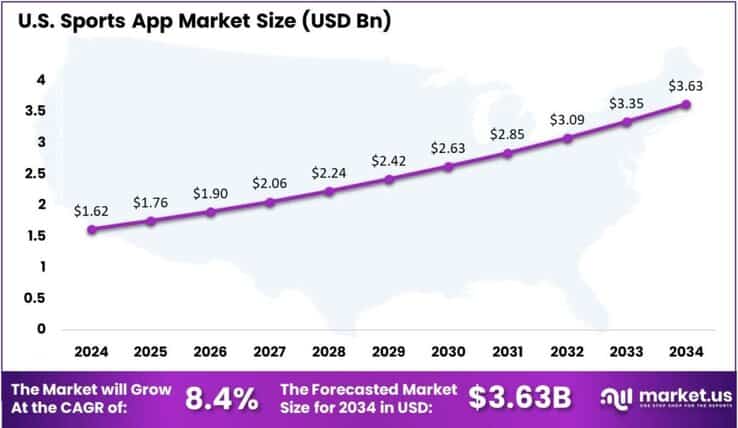

In 2024, North America held a dominant market position, capturing more than a 36% share of the global Sports App market and generating approximately USD 1.71 billion in revenue. This leadership is largely attributed to the region’s deeply rooted sports culture, widespread smartphone adoption, and the increasing reliance on digital platforms for real-time sports engagement.
North America’s sports app dominance is fueled by strong consumer demand for premium content and the rapid growth of in-app betting, enabled by legal reforms. Industry leaders like ESPN and FanDuel are redefining fan engagement through integrated data, betting, and tech-driven features like AI content, AR visuals, and voice updates.
Another major factor contributing to North America’s lead is the highly developed digital infrastructure and robust investments in sports tech innovation. The presence of top-tier mobile app developers, advanced analytics providers, and a growing ecosystem of startups focused on sports engagement have fostered a favorable environment for continuous app evolution.
North America’s technological maturity, consumer readiness, and strong support from sports leagues maintain its leadership in the global sports app market. The region is expected to retain its dominance in the coming years, driven by 5G connectivity and the rise of cross-platform media consumption, which will further enhance mobile sports interactions.


Platform Analysis
In 2024, Apple iOS Store segment held a dominant market position, capturing more than a 58% share in the global sports app market. This leadership can be attributed to the high concentration of premium users on the iOS ecosystem, who are more inclined to spend on app subscriptions, fitness plans, and in-app purchases.
A major strength of the Apple iOS Store is its seamless integration with Apple’s hardware ecosystem, particularly the Apple Watch and HealthKit. This allows iOS sports apps to offer effective fitness tracking, performance monitoring, and real-time health insights, with smooth syncing across iPhone, Apple Watch, and other devices for enhanced workout logging, step tracking, and heart rate analysis.
Moreover, iOS users are typically more engaged in wellness and fitness activities, with a higher likelihood of adopting personalized workout apps, live sports streaming platforms, and gamified training apps. This behavior provides a fertile ground for sports app developers targeting a health-conscious and tech-savvy audience.
Additionally, Apple continues to invest in developer tools, subscription monetization models, and health-focused innovations that further support the growth of sports applications. With the launch of new APIs and features related to augmented reality, fitness tracking, and biometric data, iOS apps can continue to differentiate themselves and offer immersive experiences.
Key Market Segments
By Platform
- Apple iOS Store
- Google Play Store
Key Regions and Countries
- North America
- Europe
- Germany
- France
- The UK
- Spain
- Italy
- Rest of Europe
- Asia Pacific
- China
- Japan
- South Korea
- India
- Australia
- Singapore
- Rest of Asia Pacific
- Latin America
- Brazil
- Mexico
- Rest of Latin America
- Middle East & Africa
- South Africa
- Saudi Arabia
- UAE
- Rest of MEA
Driver
Rising Smartphone Penetration and Digital Engagement
The global rise of smartphones has significantly boosted the adoption of sports apps, especially in North America. As mobile device use becomes more widespread, sports fans increasingly turn to apps for real-time updates, live streaming, fitness tracking, and interactive features.
High-speed internet and advanced mobile technologies have further improved the user experience, driving higher app downloads and engagement. The rise of esports and virtual sports has expanded sports apps to attract gamers and non-traditional sports fans.
Additionally, digital payment systems have simplified in-app transactions, boosting user retention. The growing smartphone penetration, along with advances in mobile technology and digital payments, has fueled the sports app market’s growth, a trend expected to continue as technology evolves and user preferences shift towards more interactive experiences.
Restraint
Data Privacy Concerns and Regulatory Challenges
The growth of the sports app market faces challenges from data privacy concerns. Users and regulators are wary of personal data collection, with incidents of breaches and unauthorized sharing eroding trust. The increasing use of biometric data through wearables adds further privacy risks, prompting regulators to call for stronger data protection measures.
Navigating overlapping privacy laws, like HIPAA and state regulations, complicates compliance for app developers. Non-compliance can lead to legal issues and harm brand reputation. In conclusion, data privacy concerns and regulatory challenges are key restraints on the sports app market, making transparent data practices and strong security measures essential for maintaining user trust and growth.
Opportunity
Integration with Wearable Technology
The integration of sports apps with wearable technology presents significant market growth opportunities. Wearables like fitness trackers and smartwatches enable real-time data collection, enhancing user engagement with features such as heart rate monitoring, sleep tracking, and personalized workout plans. This integration improves user experience and provides valuable data for ongoing app enhancement.
The fusion of fitness apps, wearables, and AI is creating a more connected and personalized wellness experience. This synergy enables innovative features like biometric nutrition plans and virtual fitness communities, broadening the scope of sports apps. As technology continues to evolve, the integration of wearable technology with sports apps is set to play a crucial role in shaping the future of the market, driving innovation and enhancing user engagement.
Challenge
User Retention and Engagement
Despite a growing user base, sports app developers face challenges in user retention and engagement. High churn rates suggest users abandon apps quickly, often due to factors like lack of engaging content, poor user experience, and aggressive monetization. To retain users, apps must offer immersive, personalized experiences and consistently fresh content.
To address retention challenges, some apps have introduced loyalty programs and gamification, like CBS Sports, which has optimized user acquisition channels to boost retention. These strategies enhance engagement by offering incentives and a sense of achievement. However, implementing such tactics demands significant resources, ongoing innovation, and careful balance between personalization and privacy to ensure user comfort.
Emerging Trends
Several key trends are shaping the development of sports apps, with AI playing a central role. It is being integrated to provide personalized content, real-time statistics, and predictive analytics, offering users tailored updates and insights. These features enhance engagement and satisfaction by delivering detailed performance metrics and game predictions, enriching fans’ understanding of the sport.
Sports apps are increasingly compatible with wearable devices, allowing users to track their fitness metrics and receive health insights. This integration supports users in monitoring their physical activities, setting goals, and maintaining a healthy lifestyle, thereby extending the app’s utility beyond mere entertainment.
Gamified elements, such as leaderboards, achievements, and fantasy leagues, are being incorporated to boost user engagement. These features encourage regular interaction with the app, fostering a sense of competition and community among users.
Key Player Analysis
NBC Universal stands out as a key player in the sports app market, primarily due to its robust media portfolio, including the Olympic Games, NFL, and Premier League broadcasts. Their sports app, Peacock, allows users to access live sports events, exclusive content, and on-demand features. NBC’s established reputation in broadcasting, combined with its powerful streaming platform, makes it a formidable force.
Warner Media, now part of the newly formed Warner Bros. Discovery, has made significant strides in sports streaming with its platform, Max. Warner Media holds exclusive broadcasting rights to major leagues like the NBA, MLB, and NCAA. Their sports app offers live broadcasts, replays, and original content, leveraging strong league relationships and global reach to attract a wide user base.
PENN Entertainment has recently become a major player in sports streaming, largely thanks to its acquisition of Barstool Sports. PENN integrates sports betting with live streaming through its app, creating a unique offering. With partnerships with major sports leagues, it taps into the growing demand for interactive experiences, positioning itself as a distinct player in the market.
Top Key Players in the Market
- NBC Universal
- Warner Media
- PENN Entertainment
- ESPN
- Viacom18 (JioCinema)
- Sky UK
- SuperSport
- LiveScore
- beIN SPORTS
- DAZN
- Fubo TV
- Others
Top Opportunities for Players
- Personalized User Experiences Through AI: Artificial Intelligence (AI) is enabling sports apps to offer tailored content, enhancing user engagement. By analyzing user behavior and preferences, apps can provide customized notifications, content recommendations, and interactive features. This personalization fosters deeper user involvement and loyalty.
- Integration of Wearable Technology: The adoption of wearable devices is transforming how users interact with sports apps. Integration with wearables allows for real-time health and performance tracking, offering users insights into their physical activities. This synergy between hardware and software enhances the utility and appeal of sports applications.
- Expansion into Emerging Markets: Emerging economies are witnessing a surge in smartphone penetration and internet accessibility, creating fertile ground for sports app growth. Localized content and language support can help apps resonate with diverse user bases, tapping into previously underrepresented markets.
- Diversification into E-sports and Fantasy Leagues: The rising popularity of e-sports and fantasy sports leagues offers avenues for sports apps to diversify their offerings. By incorporating features that cater to these segments, apps can attract a broader audience and create additional revenue streams through in-app purchases and advertising.
- Enhanced Fan Engagement Through Interactive Features: Interactive elements such as live polls, quizzes, and social sharing options are becoming integral to sports apps. These features not only increase user engagement during live events but also foster a sense of community among users, encouraging repeat usage and brand loyalty.
Recent Developments
- In February 2024, ESPN, FOX, and Warner Bros. Discovery announced plans to form a joint venture to launch a new streaming sports service in the U.S. This service is scheduled to debut in the fall of 2024 and will be available directly to consumers via a new app.
- In December 2024, DAZN announced the acquisition of Foxtel Group, a leading Australian sports and entertainment media company, for $3.4 billion. This deal aims to leverage DAZN’s global scale and technology to enhance Foxtel’s offerings.
Report Scope

